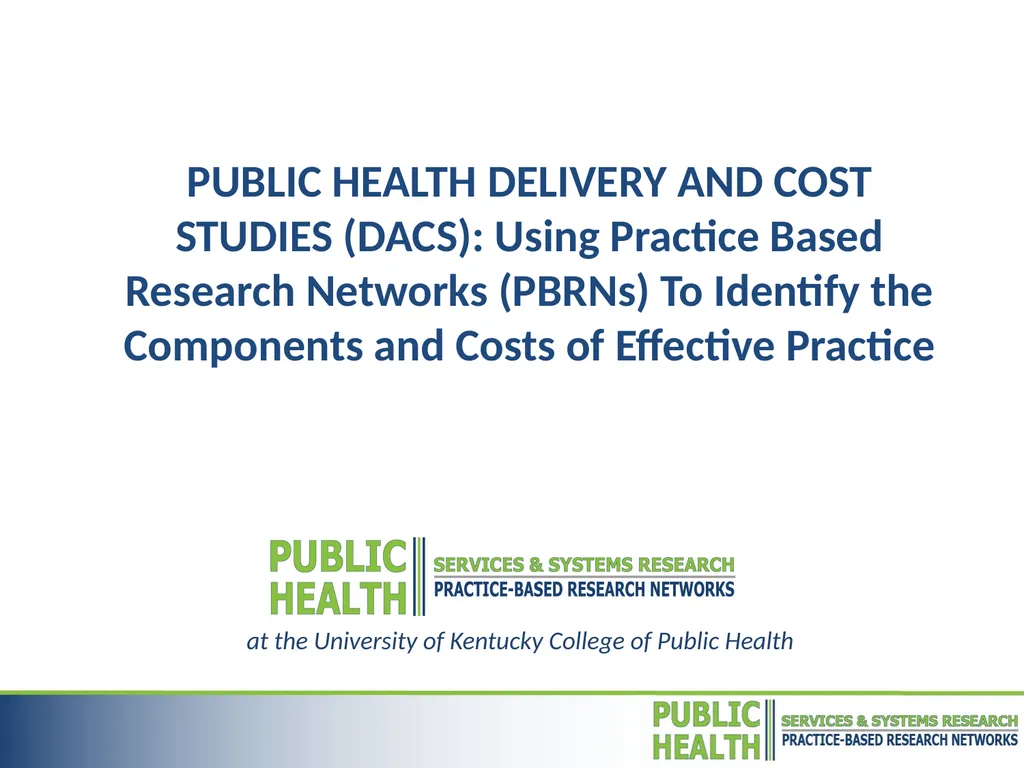at the University of Kentucky College of Public
Author : conchita-marotz | Published Date : 2025-06-27
Description: at the University of Kentucky College of Public Health PUBLIC HEALTH DELIVERY AND COST STUDIES DACS Using Practice Based Research Networks PBRNs To Identify the Components and Costs of Effective Practice Public Health PH Practice
Presentation Embed Code
Download Presentation
Download
Presentation The PPT/PDF document
"at the University of Kentucky College of Public" is the property of its rightful owner.
Permission is granted to download and print the materials on this website for personal, non-commercial use only,
and to display it on your personal computer provided you do not modify the materials and that you retain all
copyright notices contained in the materials. By downloading content from our website, you accept the terms of
this agreement.
Transcript:at the University of Kentucky College of Public:
at the University of Kentucky College of Public Health PUBLIC HEALTH DELIVERY AND COST STUDIES (DACS): Using Practice Based Research Networks (PBRNs) To Identify the Components and Costs of Effective Practice Public Health (PH) Practice Based Research Networks (PBRNs) National program of the Robert Wood Johnson Foundation (RWJF) that supports research-practitioner networks in improving delivery of PH services PBRNs combine multiple PH agencies with research partners to design & implement comparative studies in real-world practice settings PH Delivery and Cost Studies Award (DACS) support studies to identify costs of delivering high value PH services & elucidate influence of delivery system characteristics on efficiency, effectiveness, & equity of services. BACKGROUND Wide variation in scope & scale of PH activities across communities & their financial & institutional arrangements Gaps in knowledge on causes & consequences of variation; resources required to deliver PH services for a defined community & group (Carande-Kulis et al., 2008) Lack of empirical evidence related to the “production function” of PH activities Essential to informing PH funding decisions & sound economic justifications for PH investments (e.g. Neumann et al., 2009) Guide financial management decisions of PH agencies in priority-setting & evaluation of efficiency & cost-effectiveness of PH strategies (Kindig & Mullahy, 2010) WHY FOCUS ON COSTS 1/2 Lack of systematic knowledge about costs of delivering PH services → decision-makers to rely more on historical precedent > empirical data in establishing fiscal priorities, financial mechanisms, & operating budgets (Budetti & Lapolla, 2008) 2012 Institute of Medicine Recommendations Identified high priority need for studies that explicate components & costs of a minimum package of public health services WHY FOCUS ON COSTS 2/2 Institute of Medicine. For the Public’s Health: Investing in a Healthier Future. Washington, DC: National Academies Press; 2012. foundational capabilities basic programs Costs incurred in delivering PH services shaped by: Delivery system structure & operation Pop. Characteristics Nature & quality of services Delivery system is a complex mix of governmental, private, community, non-for-profit, & other contributing organizations Question of how delivery system characteristics influence costs Level of resources required to deliver a given bundle of PH activities for a given population How do delivery costs vary across communities & population groups DACS policy relevance for efficiency & ROI Where are the opportunities to realize efficiencies in delivery? Do outcomes achieved by PH interventions justify their costs? Where should new investments be directed to achieve greatest impact? General Analytical Framework














